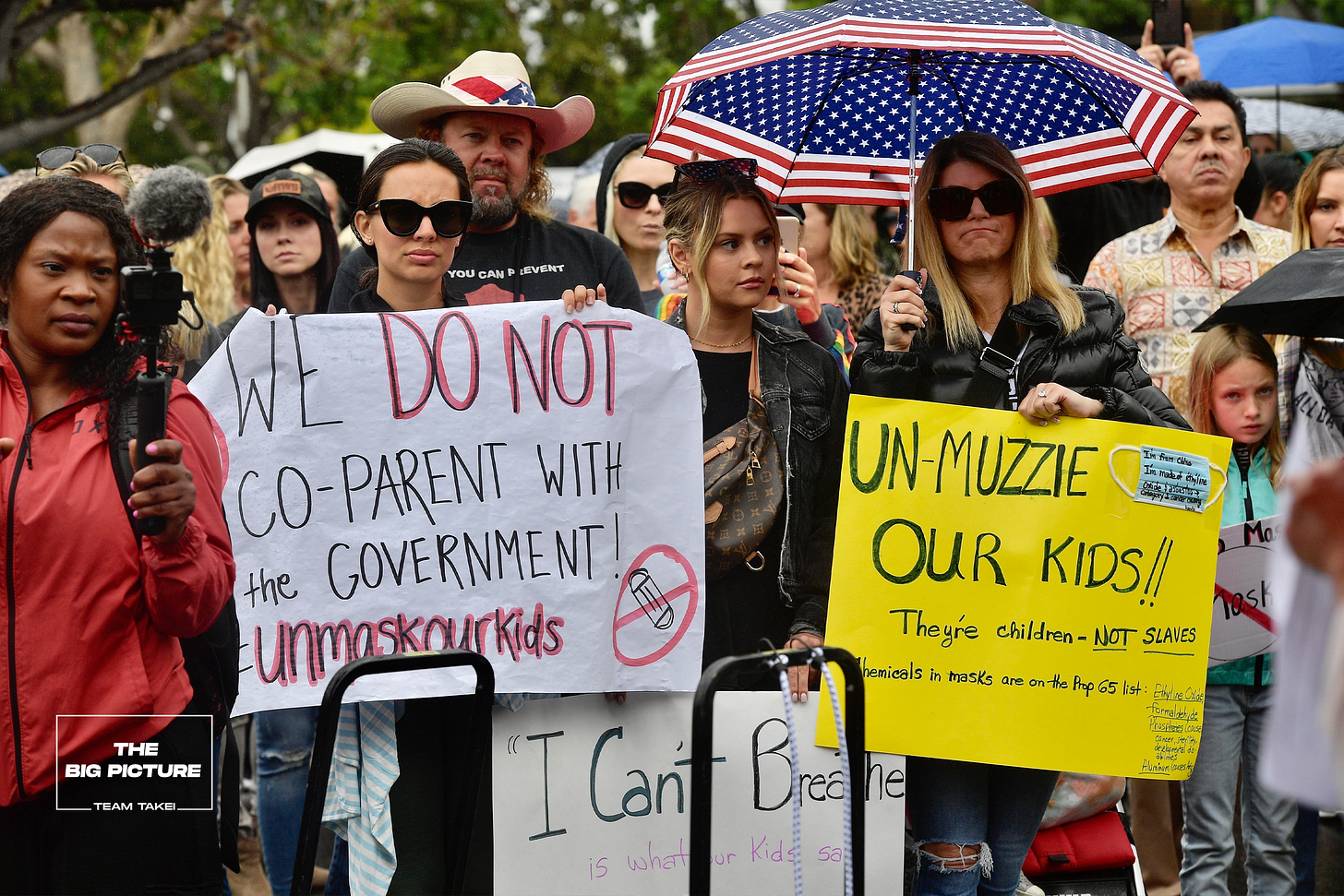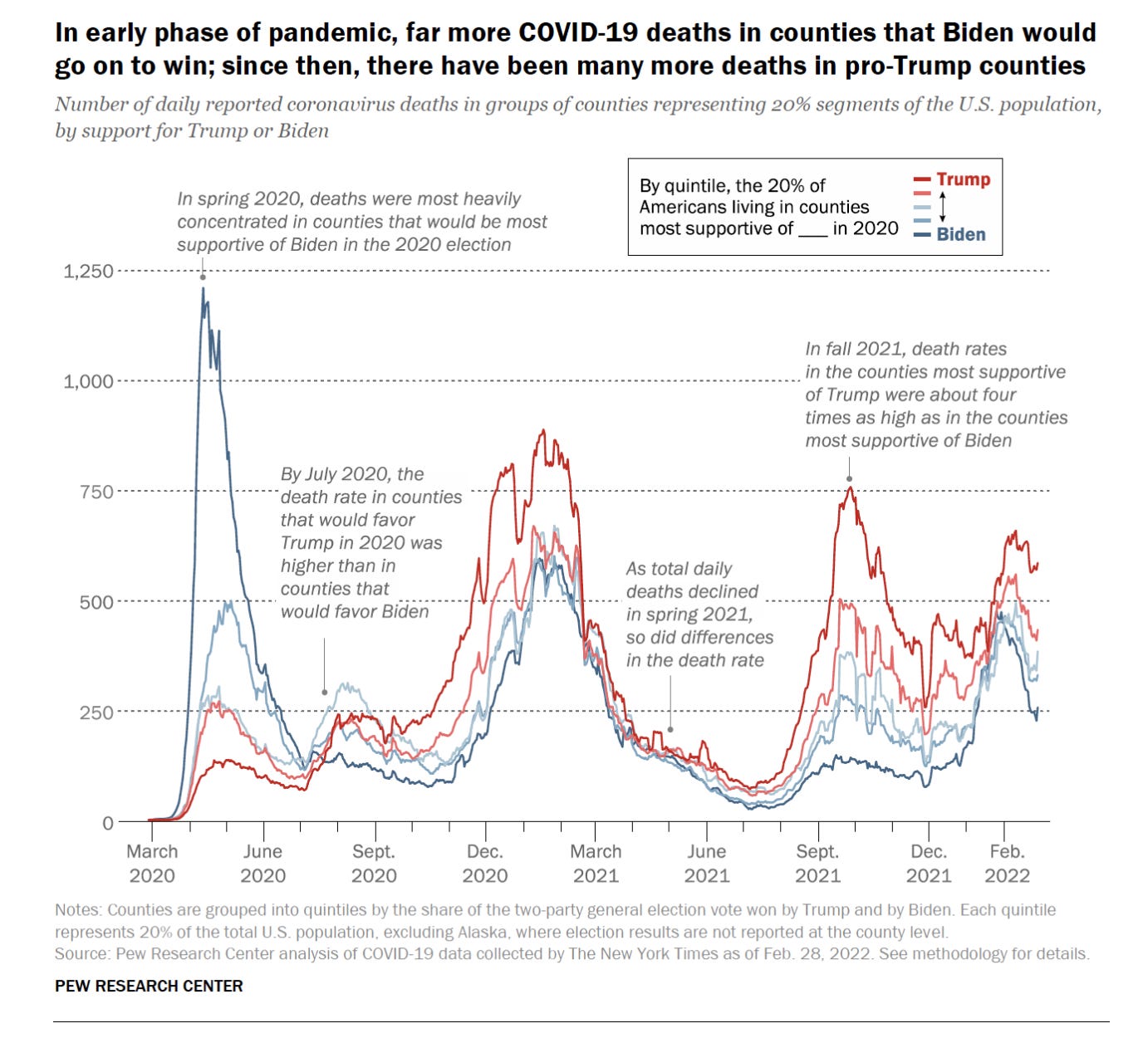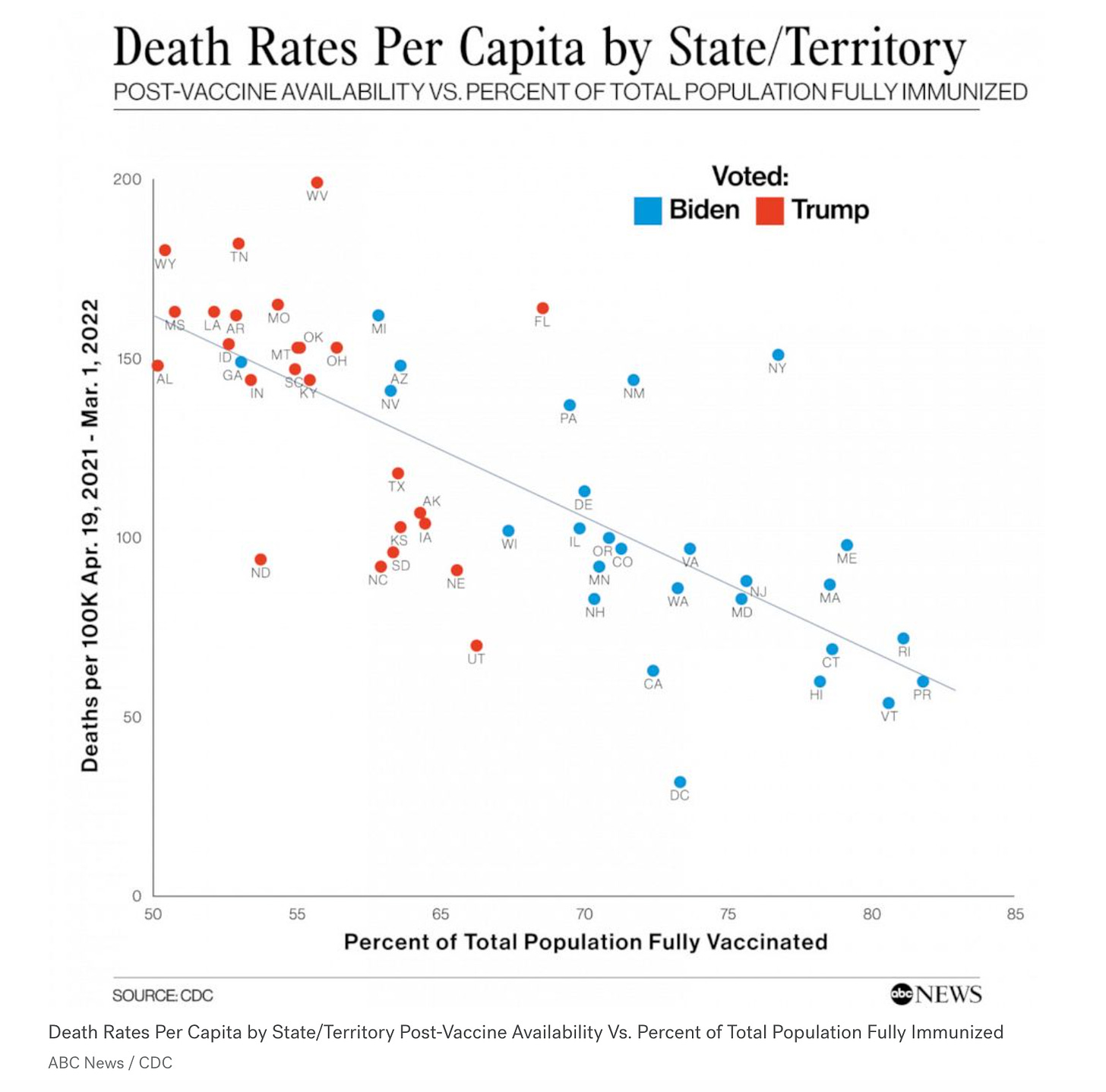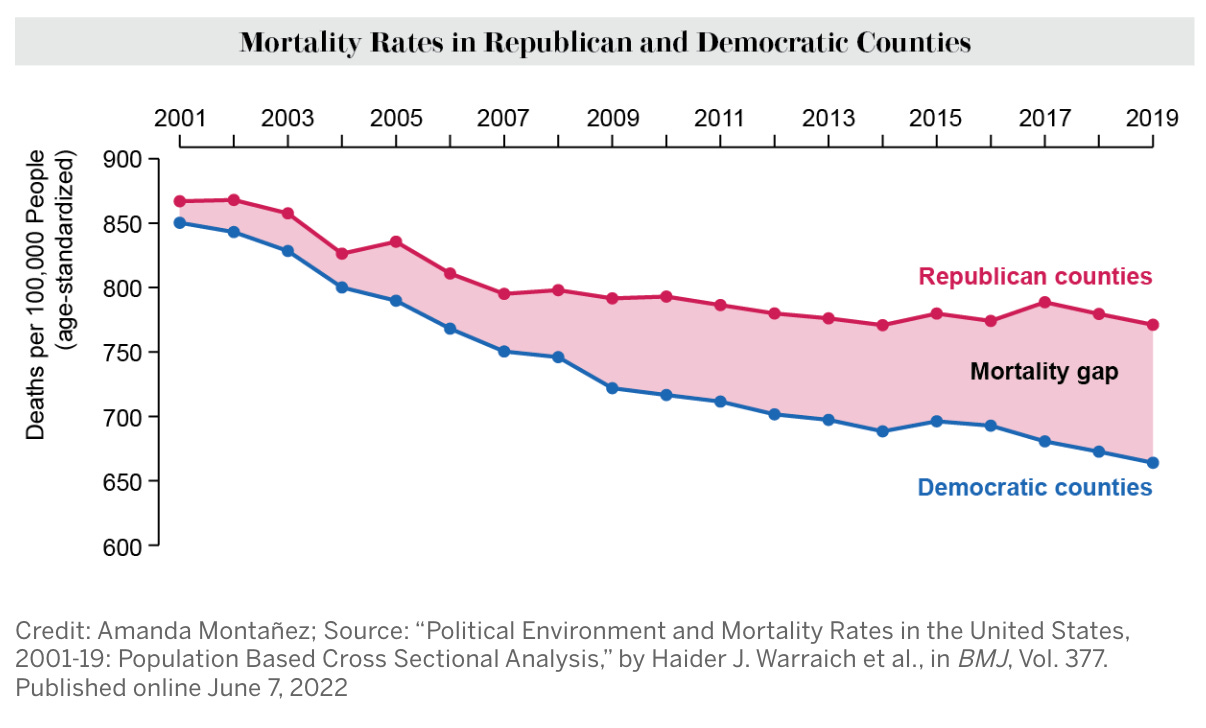Red State Politicians Are Killing Their Own Constituents
Covid may have brought the health impacts of red state policies to light, but it's a phenomenon decades in the making.

Beginning in 2020, the Covid-19 pandemic brought to light a clear divide in health outcomes between those who live in red (Republican-leaning) counties and those who live in more pro-Democratic blue counties.
The more liberal the area, the more likely mask mandates, social distancing, and vaccine requirements would be implemented and followed, while the more conservative the area, the less likely that would be the case.
As a result, even though Covid’s initial spike in deaths and hospitalizations was concentrated in densely populated blue cities, it didn’t take much time for that to flip, resulting in a disproportionately greater number of hospitalizations and deaths due to Covid in red areas.
But this stark difference in health outcomes based on where Americans live is hardly a new phenomenon. This trend has been evident for decades thanks to conservative policies that simply put their constituents at greater risk.
As The Washington Post recently put it in their headline:
How Red-State Politics Are Shaving Years Off American Lives
This phenomenon can be traced back to conservative hero Ronald Reagan in the 1980s, who empowered states to take ownership of how federal dollars were spent.
In this piece, I’ll look at the differences in mortality rates in red vs. blue areas of the U.S. over time and how we got to such a stark and disturbing divide.
The Covid Death Red State / Blue State Divide
According to Pew Research Center, in March 2020 at the onset of the Covid pandemic, 59% of Democrats and Dem-leaning independents felt Covid was a “major threat to the health of the U.S. population.” For Republicans and conservative-leaning independents, that number was just 33%. Cut to 11 months later, that gap widened with 82% of Democrats believing it posed a major threat and only 41% of Republicans thinking it did.
The behaviors of Americans in response to the pandemic tracked along partisan lines as well, along with policies enacted by elected leaders. The health outcomes that arose from those policies would tragically also track similarly.
As blue states and cities embraced mask and then vaccine mandates, as well as a culture of mitigation measures such as social distancing, Republican-leaning areas increasingly rejected them. And the results were entirely predictable.
According to Scientific American:
The consequences of those differences emerged by the end of 2020, when rates of hospitalization and death from COVID rose in conservative counties and dropped in liberal ones. That divergence continued through 2021, when vaccines became widely available.
Pew Research found that during the third wave of the pandemic, which lasted from late 2020 into early 2021, the Covid death rate among the 20% of Americans who lived in the counties that voted for Trump at the highest rates was a whopping 170% that of those Americans who lived in the top Biden counties.
By the Fall of 2021, that gap rose to nearly 400%.
Once vaccines became widely available to all Americans in April 2021, the red-state / blue-state political divide had become so acute that according to an ABC News analysis of CDC data, the 10 states with the highest vaccination rates had all voted for Biden and 9 of the 10 states with the lowest vaccination rates had voted for Trump.
And as a result:
“...the death rates in states that voted for Trump were more than 38% higher than in states that voted for Biden.”
Notably, the six “blue” states along the left side of the chart above are really the “purple” ones, won by smaller margins: Georgia, Michigan, Nevada, Arizona, Wisconsin, and Pennsylvania.
Drilling down to look at data in specific red states, the National Bureau of Economic Research released a study analyzing excess death rates in Florida and Ohio during the pandemic.
As Medical Economics summarized it:
From March 2020 to December 2021, a time overlapping with the COVID-19 pandemic, average excess death rates were 76% higher among Republicans than Democrats. That grew to a 95% difference when measured from March 2020 to March 2021, and a 153% difference after April 5, 2021, “when all adults were eligible for COVID-19 vaccines in Florida and Ohio,” the study said.
In other words, the data bears out what so many on the left have long suspected: that Republican politicians and lawmakers, most of whom were getting vaccinated and were voting absentee themselves, were ultimately killing their own voters with their rhetoric and policies.
This Is Not A New Phenomenon
Sadly, this trend of Republicans ignoring the life-or-death consequences of their policies is not a new phenomenon, nor is it unique to a global pandemic.
As Haider J. Warraich, a physician and researcher at the VA Boston Healthcare System and Brigham and Women’s Hospital in Boston told Scientific American:
“COVID has really magnified what had already been brewing in American society, which was that, based on where you lived, your risk of death was much different.”
In 2022, Warraich headed up a study comparing mortality rates in Republican counties to those in Democratic counties from the years 2001-2019, just before Covid hit. Their findings confirm that while the mortality rate gap between these groups was minimal at the start of that period, by 2019, Democratic death rates had dropped at a significantly steeper rate.
Overall, the U.S. mortality rate has decreased in the nearly two decades since then…But the improvement for those living in Republican counties by 2019 was half that of those in Democratic counties—11 percent lower versus 22 percent lower.
The study found that the gap in mortality rates between Republican counties and Democratic counties (as identified by presidential vote) widened over that period for 9 out of the top 10 causes of death, among them: heart disease, cancer, lung disease, unintentional injuries, and suicide.
Political environment, the authors suggest in the paper, is a “core determinant of health.”
An editorial that accompanied the study attributes the higher mortality rates in red areas of the U.S. to a relatively recent political trend:
Republican governors and legislatures adopted more conservative policies that affected population health, such as opposing Medicaid expansion, minimum wage legislation, and tobacco and gun controls.
And warns:
While gridlock in Washington, DC incapacitates the federal government, Republican leaders in dozens of state capitols are passing laws to undermine health and safety regulations, ban abortion, limit LGBT+ rights, and implement more conservative policies on voting, school curriculums, and climate policy.
One study, titled U.S. State Policies, Politics, and Life Expectancy, traced the phenomenon back even further.
Looking at life expectancy trends from 1970 to 2014, the study found that “states that implemented more conservative policies were more likely to experience a reduction in life expectancy.”
And looking at trends over time between just two states: red state Oklahoma and blue state Connecticut, the study found that:
in 1959 a person in Oklahoma could expect to live, on average, about the same number of years as a person in similar circumstances who lived in Connecticut…
But by 2017 Connecticut’s citizens had a five-year advantage in life expectancy over their peers in Oklahoma, which is a politically conservative state.
Take The Cigarette Tax As An Example
The Washington Post compared the impact of tobacco regulation policy on life expectancy in three adjacent states with differing politics: red Ohio, purple Pennsylvania, and blue New York.
According to an analysis of 2019 data, as many as 20% of Ohio’s citizens will die before they turn 65. The culprit?
The state, whose legislature has been increasingly dominated by Republicans, has plummeted nationally when it comes to life expectancy rates, moving from middle of the pack to the bottom fifth of states during the last 50 years.
Ohio, which has the loosest tobacco regulations among the three states as a result of Republican governance, also had the highest smoking rate: in 2019, 21% of Ohioans smoked, compared to 17% of Pennsylvanians and just 13% of New Yorkers.
It’s not an accident that cigarette taxes, which are well known to reduce smoking rates and as a result, increase life expectancy, are three times higher in New York than in Ohio.
Also not an accident: New York has the third highest life expectancy in the country, while Ohio, whose Republican legislature rejected a 2015 attempt to raise the cigarette tax by $1, ranks in the bottom 20%.
How Did We Get Here?
According to The Washington Post, this health outcome divergence along partisan geographic lines began in the early 1980s, when Ronald Reagan pushed to empower state lawmakers to direct how federal safety net dollars were spent. As a result, “conservative lawmakers often [balked] at public health initiatives they said cost too much or overstepped.”
The “Republican Revolution” of 1994 when Newt Gingrich rose to power as Speaker of the House in reaction to Bill Clinton’s election, and the Tea Party movement of 2010 after Barack Obama was elected, are noted by researchers as other inflection points in this trend.
Ideologically, of course, it tracks since, as Scientific American puts it:
Conservatives tend to see health as a matter of individual responsibility and to prefer less government intervention. Liberals often promote the role of government to implement regulations to protect health. The Democratic approach has included expanding Medicaid under the Affordable Care Act.
Other areas where Democrats are more aggressive about legislating the health and well-being of Americans are on gun safety regulations, affordable housing, and mental health access.
Which has led us to our current moment:
Today, people in the South and Midwest, regions largely controlled by Republican state legislators, have increasingly higher chances of dying prematurely compared with those in the more Democratic Northeast and West, according to The Post's analysis of death rates.
In the end, according to the US State Policies, Politics, and Life Expectancy study, researchers found that if all states in the U.S. implemented liberal policies, life expectancy nationwide would increase on average by 2.8 years for women and 2.1 years for men.
This means this trend is reversible, but that would require one of two things to happen:
Republicans would have to be voted out and replaced by Democrats; or
Republicans who rule these red states would have to begin to place the health of their constituents ahead of political ideology.
It’s unclear which of those is more likely, but it does absolutely mean that issues like voting rights and gerrymandering are public health issues as well.








good to see some specific and organized data supporting what we have all long suspected to be true.
I was all set to spend my retirement in a low living cost red state until I realized it really does make a difference where you live - both in terms of presence of actual physical or institutional resources and in terms of political attitudes. Now I would consider moving to a red state as a grace health risk. And they don't seem to care.